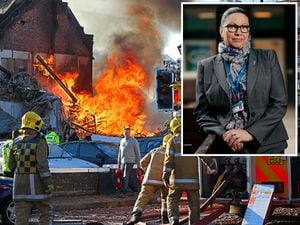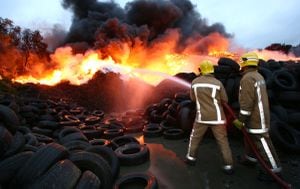The disaster artist at work: Meet the woman getting Shropshire ready for a large-scale catastrophe to strike
A huge catastrophic might only ever be just around the corner and we speak to the woman who has headed up Shropshire's plans in case a big emergency strikes the county.

In 2009 an outbreak of swine flu swept across the globe. Cases, which varied wildly in severity, spread across nations.
In the UK 360 people died. Among the cases were more than 1,000 in the West Midlands.
Flu epidemics often invoke talk of catastrophes such as the Spanish flu outbreak of the early 20th century, in which between 50 and 100 million people around the world died.
So what would happen to a local area in the event of a catastrophic event?

Lianne Deathridge has been the woman in charge of Shropshire Council’s Emergency Planning Unit for more than a decade, her tenure coming to an end when she moved to Walsall Council this week.
Her role has made her responsible for coming up with plans in case of an emergency such as a flu pandemic.
“It’s one of our top risks,” says Lianne, sitting in the council’s emergency control room at Shirehall in Shrewsbury.
The walls are surrounded by white boards containing different information, a rolling news screen and a large round table for urgent meetings and video conference calls.
The Government agree a flu pandemic is one of the most severe natural challenges that could hit the UK.
We are now in an interpandemic phase – the period between pandemics. In the event of an outbreak, there is an alert phase when a new subtype of flu is identified in humans.
Lianne says that there have to be emergency plans in place for a variety of eventualities to prepare for worst-case scenarios, combining agencies such as the police, fire and NHS. After that there would be an increase in vigilance and risk assessment so the teams are prepared for phase two – pandemic, when influenza spreads across the globe, as happened in 2009.
“There would be re-assuring public health messages going out from Public Health England and we would be reiterating those,” says Lianne.

“It would say things like don’t go out unless you really have to, if you can get a flu jab then we would recommend that you do so, and if you are concerned about someone and haven’t seen them for a while then report it.”
As well as making sure that council services run smoothly and priorities of those services are changed, council staff would be trained to help with administering vaccinations and helping vulnerable people.
But in the background there would also be more difficult decisions being made.
“We would have plans activated to support the hospitals including an excess deaths plan where we look at capacity,” Lianne says.
“When such an incident does happen there is potential for our mortuaries not to cope with demand, which would not only happen in Shropshire but up and down the country too.
“We would be looking at alternative storage and working with funeral directors across the county with the approval of the coroner. We would look at all the funeral directors in the county and their capacity. Who is full? Who has got space?
“Once the mortuary at the hospitals fill up they have the ability to call in what are called Nutwell Units, which we have on standby and they hold 16 bodies or body parts.”
Lianne says the council has deployed these units to the hospitals over the last two years – and that is without a pandemic.
If one was to hit, nationally in the UK, up to half of the population may become infected and it is expected there would be between 20,000 and 750,000 additional deaths.

It is estimated that ver a 15 week period there could be 5,917 deaths across Telford and Shropshire.
This figure is calculated by the Government’s national planning assumptions assessments tool using data and population figures taken from the 2011 census, and estimates there would be up to a 2.5 per cent increase in deaths.
The capacity for bodies in mortuaries at the Royal Shrewsbury Hospital, the Prince Royal in Telford and in community hospitals at Bishop’s Castle, Ludlow and Whitchurch is 131.
“By week three we will start struggling,” said Lianne. “That is when the funeral directors would be contacted, the cremations would have to increase and the number of funerals that take place would have to increase to make sure we can process the people with the respect they deserve instead of them waiting there.”
The excess death plan and the emergency mortuary plan would be implemented in cases like a flu pandemic and there was a slower increase in deaths that the council were aware of – but if there was a bigger catastrophe or accident that had an immediate impact the council would look to implement a mass fatality plan.

Shropshire has had its share of disasters – Shrewsbury’s gas explosion in 2010, for example – and while these did not result in mass fatalities, the planning has to be there.
“The mass fatalities plan is for an immediate impact, something you can’t plan for and did not see coming but has a very big impact on the community,” says Lianne.
Like many authorities across the UK, Shropshire Council has a contract with a specialist crisis and disaster management company. They have to get a disaster site up and running in 72 hours.
“Hopefully for West Mercia it will never happen to us, but you never know,” she says. “We are working with the wider West Midlands to make sure our resources and equipment are fit for purpose to respond, but we have locations identified if we had to activate such a plan.
“The company would come in and supply us with certain things, then the Disaster Victim Identification would come in.”
The police would also activate a free information and helpline and there are also agreements with BT to make sure there is still mobile phone reception.
“We don’t know what we don’t know, but what we do know, we plan for,” she says. “Fortunately we have never to use the plans in anger, but we do test them.”
There is a Shropshire risk category which identifies certain risks specific to the county.
These include a major fire at a major waste site like the Kingpin fires of 2009, explosion of gas storage units, a prison riot, collapse disused of mines and the top priority is a potential landslip at the Ironbridge Gorge.
“I hope it will never go in our time, but there is still the possibility and we have to be prepared and be wise to our risks,” she says.
“We are always learning and we don’t know everything. Every incident is different and you respond differently to every incident.”





